Politics
Seeking to change narrative, Oli resorts to show of force
Despite leading the government, Oli is holding a mass gathering in front of Narayanahiti, once the seat of kings, raising concerns if the communist prime minister is taking the country on a regressive path.
Binod Ghimire
Even though Nepal earned its much-cherished democracy in 1990, it took the country yet another people’s movement—in 2006—and two constituent assemblies to achieve a “people’s constitution” that established a secular state under a federal republican system.
Nepal’s constitution is now a little over five years old. A government that was installed by the first elections under the new constitution was about to complete its third year. And then Prime Minister KP Sharma Oli took a step that left everyone stunned.
Despite leading a nearly two-thirds majority government, Oli on December 20 dissolved the House of Representatives, in a move that many say does not authorise him to do so, raising the spectre of a political instability against which the country was fighting for so long.
Oli has decided to seek a fresh mandate on April 30 and May 10—a year and a half before the scheduled elections—making the term “stability” farcical.
But what is more concerning, observers say, is that Oli appears bent on destroying the hard-earned gains like the constitution, secularism and federal republicanism.
In what his faction of the Nepal Communist Party says is a “show of strength”, it has planned a mass gathering in Kathmandu on Friday. And the venue the party has selected is Durbar Marg, the Capital Kathmandu’s posh downtown in front of the former palace of the monarchs.
After Gyanendra, the last of the monarchs of the over two centuries-old Shah dynasty, on June 11, 2008 had declared from the same palace that he was abdicating.
Political analysts say Oli of late has been making every attempt to win over the pro-Hindu, pro-monarchy constituency and his party’s plan to hold a mass gathering in front of the former royal palace just buttresses that theory, even though some may call it a conspiracy.
“There is a symbolic meaning in holding the gathering at Durbarmarg,” said Surendra Labh, a political commentator. “His visit to Pashupatinath temple to offer a special puja, his declaration that he will turn Ayodhyapuri in Chitwan a Hindu pilgrimage and now a gathering of his party in the Narayanhiti area indicate that he is in a bid to woo the pro-Hindu, pro-monarchy constituency.”
Ever since Oli dissolved the House, the other faction of the Nepal Communist Party—led by Pushpa Kamal Dahal and Madhav Kumar Nepal—has been holding protests and mass demonstrations in Kathmandu and various parts of the country. Political parties like the Nepali Congress and Janata Samajbadi Party too have taken to the streets to protest against Oli’s House dissolution.
Oli, however, does not seem to be much concerned about the Congress or Samajbadi Party’s protests.
By his own admission, Oli is trying to counter the Dahal-Nepal faction by organising the gathering.
But many are left wondering.
Nepal has gone through political upheavals over the past two decades, but it has always been a case that those out of the government organise protests or gatherings against the establishment. Oli's party, however, is in a bid to stage a show of strength despite it being the establishment.
Analysts say Oli seems to be in a bid to prove the legitimacy of his government, which he himself has reduced to the caretaker status by dissolving the House.
According to Devendra Raj Pandey, a civil society member, the government of the day proves its legitimacy through its actions—good governance, public welfare works, development, and service delivery.
“I am hearing for the first time after 1990 that a party in the government is showing its strength from the streets and through a demonstration and gathering,” Pandey told the Post. “It’s Parliament or press conferences from where a government defends its actions.”
There was, however, a time when the Panchayat regime organised such mass meetings to “tell” people how good it was doing for the country and the society.
Pandey said once such an event on behalf of the establishment was organised during the Panchayat era by then prime minister Marichman Singh Shrestha.
Now the venue Oli's party has chosen to blow its trumpet too has baffled many, as Narayanhiti, until Gyanendra was forced to abdicate, was viewed as the source of power for the monarchs and the emblem of "Hindu kingdom" with kings regarded as an incarnation of lord Vishnu.
Analysts say if what Oli has been doing and how he has been doing things are anything to go by, it is becoming apparent that he was never committed to the secular federal republic.
“It is very much clear by now that Oli is trying to woo the pro-monarchy, pro-Hindu constituency,” said Rajendra Maharjan, a political commentator for the Post's sister paper Kantipur. “His real face has now been exposed.”
Whether Oli will make a big announcement at Thursday's gathering is still not clear but his opponents have already started making speculations that he would try to do something that could take the country on a regressive path.
Oli’s opponents say since Oli has left the Communist ideology long behind, it won’t be a surprise if he tries to play a Hindu and pro-monarchy card.
“There are talks about Oli announcing a campaign for a Hindu nation on February 5,” said Surendra Pandey, a leader of the Pushpa Kamal Dahal and Madhav Kumar Nepal-led Nepal Communist Party on Sunday during a sit-in at Maitighar. “He now can move on this path [Hinduism].”
He added that the royalists, who once suppressed the communists, are now heaping praise on Oli, which clearly shows which path he is going to take.
Many are also baffled at some pro-Hindu, pro-monarchy advocates deciding to argue on behalf of Oli at the Supreme Court which is hearing his House dissolution move.
Sushil Pant, Surendra Bhandari, Balkrishna Neupane and Bishnu Prasad Bhattarai—some of the lawyers who have never hidden their tilt towards a pro-Hindu, pro-Hindu monarchy state—are trying to justify why Oli’s House dissolution move is right.
Many say since Oli has exhausted all the topics, including nationalism and development, he is now focusing on the issues that were consigned to history by the recent political movements.
Oli returned to power through the 2017 general elections, largely riding on the nationalistic plank in the wake of the Indian broder blockade following the promulgaton of the constitution in 2015.
Last year in May, when India opened a new road link via Lipulekh to Kailash Mansarovar in the Tibet Autonomous Region of China, it was a godsend for Oli.
Bilateral relations with India had soured since November 2019 when India published its new political map placing Kalapani within Indian borders.
But by the time the May incident happened, Oli was so cornered in the party that he decided to employ it to ratchet up his nationalist rhetoric.
However, when relations started to improve with India, Oli’s nationalist image started to fade away.
He quickly started to build a Hindu narrative.
Oli on January 25 visited Pashupatinath Temple and performed a special puja.
Four-days later, addressing a mass gathering in Chitwan on Saturday, Oli announced his plan to develop Ayodhyapuri in Thori of the district as a religious site for the Hindus. He has been claiming the area to be the birthplace of lord Ram.
Many say Oli, however, still wields the ability to turn on the charm because of his way of changing tack according to the situation.
Baburam Adhikari from Gadhawa Rural Municipality in Dang is one who refuses to believe that Oli is going on a regressive path.
The 35-year-old decided to travel to Kathmandu for Friday’s event to show his support for Oli.
Adhikari said he has always been loyal to the CPN-UML, the party Oli led before the May 2018 merger with the Maoist Centre.
“Other leaders might have left him, but I am still with the Nepal Communist Party that is led by Oli,” Adhikari told the Post over the phone.
Adhikari believes Oli is the one leader who could protect nationalism, which by extension meant a leader who could stand up to India.
“During his first stint as prime minister, he was forced to resign because he signed a slew of deals with China, including the transport and transit agreement,” he told the Post. “This time, the Dahal-Nepal faction started pulling him down ever since he decided to incorporate Kalapani and Lipulekh into Nepal’s map.”
Oli’s 2016 Transport and Transit agreement was aimed at reducing Nepal’s dependency on India and he was prompted to do so in the wake of 2015 Indian blockade. It was Oli’s tilt towards Beijing that had given him an edge over his contemporary leaders, ultimately earning him votes to return to Baluwatar.
Adhikari still believes that Oli was forced to dissolve the House because the prime minister was not allowed to function properly.
“Couldn’t they [Dahal and Nepal] wait until the party general convention? Oli had said he would hand over the leadership,” said Adhikari, who has come to Kathmandu along with his 300 “fellow comrades.”
Adhikari refuses to admit that by dissolving the House Oli had made an assault on the constitution and that his leader was trying to appease new constituencies now, including those whose agenda is a massive reversal to democratisation.
And he is not alone.
Most of Oli’s supporters consider him to be a “statesman”. On Thursday, Oli’s supporters organised a rally with the “I love you Oli” slogan.
People loyal to Oli say there is nothing wrong for a ruling party to organise a mass meeting. They also urged all not to read too much into the venue chosen by the party to organise the gathering.
Anand Pokharel, chief of the [Naryanahiti] mass gathering organising committee, said the place was chosen because no other place in Kathmandu could host over 150,000 people they are preparing to bring in on Friday.
“I have heard comments and conspiracy theories that choosing Narayanhiti as a venue for our mass gathering is an attempt to undermine republicanism,” said Pokhrel. “But such comments are so worthless that I don’t think they deserve a clarification.”
But analysts say it’s those in power who are answerable to the people the most. Just because a party leading the government is faced with some challenges does not mean it brings people on to the streets, according to them.
Pandey, the civil society member, said Oli and his party have made a mockery of democracy, governance and rule of law.
“It’s strange that the government is trying to prove its legitimacy through streets,” said Pandey, “after dissolving the most legitimate place to do so—Parliament.”




 11.12°C Kathmandu
11.12°C Kathmandu
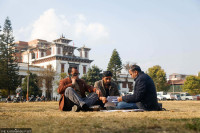
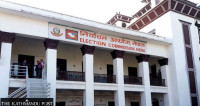

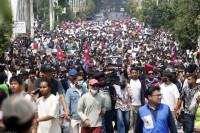
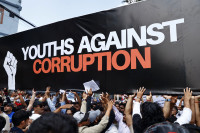
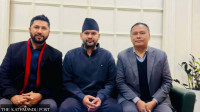



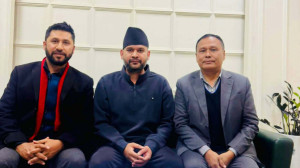



%20(1).jpg&w=300&height=200)

